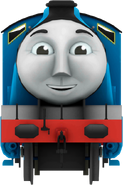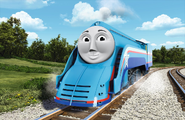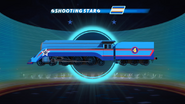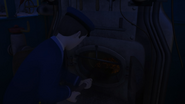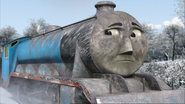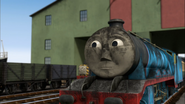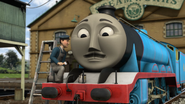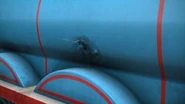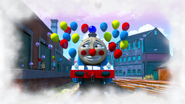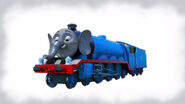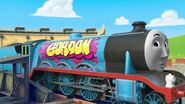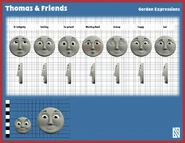
|
Background Information
Gordon is a fictional standard gauge tender locomotive created by the Rev. W. Awdry. He is the No. 4 engine on the North Western Railway.
Gordon first appeared in the first series episode Thomas and Gordon, which first aired in 1984. His last appearance was in the twenty-fourth series episode Thomas' Animal Friends, which was released in 2021.
Voice
Neil Crone voiced the character in Thomas and the Magic Railroad, giving the character a faint but noticable British accent.
Beginning with Hero of the Rails and the switch to a full voice cast for the CGI series, Keith Wickham assumed the character's role in the UK and Kerry Shale in the US. While Wickham maintains Gordon with a British accent, Kerry Shale's performance is clearly American. Much like Henry, a few of Shale's earlier lines as Gordon were lower in pitch compared to most other recordings, but became higher as the series progressed.
Behind the Scenes
Gauge 1 models


Gordon's original model was custom built to run on gauge 1 track for the Unaired Pilot. The model was built with a custom bodyshell made by model maker Martin Gill. It was painted using glossy car body paint and lined with red Trimlime pinstripe tape, with the numbers being custom cut vinyl stickers. His buffers, brake pipe, and coupling hook and chain, were made by Tenmille. The chassis was made by Bassett-Lowke [1] , but it was never tested before being filmed in front of the camera and proved to be unreliable, having to be constantly modified during filming.
The space behind the eyes in the body accommodated two miniature RC servos to allow the eyes to be moved by means of a joystick on the remote control. Often, the eyes were set and locked in a particular direction, and the static from the power coupling on the track sometimes affected the servos and made the eyes suddenly veer off wildly.
The model was equipped with a smoke generator based on a 12V car cigarette lighter, with conventional studio smoke-machine oil dripped on the hot element before each shot – but the heat proved to be sufficient enough to warp the inside of the bodyshell, so they could not be used for any length of time, and the smoke effect itself proved to be underwhelming, generating smoke rather feebly that sometimes emanated from gaps behind the eyes, or at the side of the face.
After the first series was approved for production, the model was refurbished by model maker Christopher Noulton[2], with reapplied paint and pinstriping, and later fitted with a new chassis made by Märklin, coming from their BR 78 model. This proved to be much more reliable than the previous Bassett-Lowke chassis. A new smoke mechanism was also built by model maker Tim Staffell, producing a much better puff than the first iteration using thin tubes that allowed for more controlled direction out of the funnel.
The front bogie of the BR 78 had to be shortened to fit the bodyshell, and in order to have enough parts for the other engines and Gordon himself, his front bogie was made from two front halves of the original Märklin bogie, which were bolted together using another part from the stock assembly of the bogie. The back half of one was used for his trailing wheel, and the other back half was used as the leading pony truck for James.
After these modifications, the inner sides of the cylinders had to be cut to allow the shortened bogie to navigate curves without issue. The tender wheels and frame that holds them were sourced from a BR 38 tender. It is currently unknown whether or not a complete BR 38 was acquired, as parts from just the tender have been identified. His axleguards are also other parts that have not yet been matched, although, some found on Bassett-Lowke wagons have shown to have very similar design features, but not be identical. It's not yet known if they were a mass produced set, or perhaps a heavily modified or fully custom set made for his pilot model.
The bodyshell was also modified, the front bufferbeam was moved higher up to match the other rolling stock and accommodate the new chassis, and he gained a visible saddle along his smokebox and boiler, which was needed as the new chassis was wider on the inside than his first one. The model was also fitted with lamp irons which were made from brass railing stanchions sold by EMA Models.
Gordon's plastic model was originally AC powered, as this is how all the Märklin locomotives bought for use as part donors were powered. This required the polarity switch, which was originally mounted in front of the motor, to be moved to the tender, allowing space for the smoke mechanism which sat in between the motor and eye mechanism. During a refurbishment, his AC motor was replaced by a DC motor to allow for easier running and maintenance, as this required far less wiring and components in the circuit.
During the production of the tenth series two new models of Gordon were built. This was due to the original model being twenty-two years old at this point and the tight filming schedules meant there was very little room for emergency repairs.[2]
The new models were made out of brass, equipped with a CNC machined aluminium chassis powered by a DC motor. From this point onwards the plastic model would only appear in scenes that would damage the brass models, until it was officially retired after the episode, Gordon and the Engineer.[2]
The eye mechanism had two servos, one for up and down movement and one for left and right movement. The up/down servo was attached to the body. The left/right servo had a rod attached to the arm, which connected to a bracket. The eye balls were coupled to the bracket and locked in by the face-plate, so whenever the servos were powered, the eye balls would move however the crew member desired.
Reference Sheets
Series 1
Series 2
Series 3
Series 8
Calling All Engines! (Dream Sequence)
Faces
Twenty-one different facial expressions were sculpted for Gordon, although only nineteen were used on-screen and two of which disgusted and yawning were left unused. The faces were first sculpted in clay and from that resin casts were made of a silicone mould. All of Gordon's first series faces were sculpted by model maker, Tim Staffell. Some of Gordon's faces were duplicated in case the crew needed to a face to look dirty and clean on the same day of shooting.
Reference Sheets
Usage and Evolution
Some of Gordon's faces have been mistakenly worn on Henry in the fourth series episode Peter Sam and the Refreshment Lady and the twelfth series episodes Thomas and the Billboard and Heave Ho Thomas!.
Present Day
After production of the model series ended in 2008, most of Gordon's faces were put into storage, they were paired into two groups with one group being listed as "TF00155".
Gordon's wincing and original laughing faces are owned by Twitter and Instagram user ThomasTankMerch. Gordon's disgusted face is also currently owned by Twitter user TheLilWestern, it was previously owned by Twitter user EDsTrainz who in turn bought it of ThomasTankMerch after they replaced the face with an alternate cast of the same face that better matched the cast shown in the Series 12 face sheets. The rest of Gordon's faces are currently still in storage. However, his happy, angry and grumpy faces were displayed at the "History of Thomas Exhibition" at the Midland Railway Centre in May 2019, his grumpy face would be displayed at the first Clearwater Event in 2021 as well as his smiling, tired/embarrassed, neutral, concerned/speechless (formerly annoyed), unused yawning, current sleeping, astonished and sulky faces at the Halloween Clearwater Event in 2021. The faces would then be re-displayed at the second Clearwater Event in August of 2022 and then in October of 2022 with the addition of his original sleeping, serious and worried faces, as well as a few prototype faces. The faces would then yet again be displayed at the two Tugs The Exhibition 10 Year Anniversary Events at the Midland Railway Centre in Spring and Autumn 2023.
CGI Face
The twelfth series marked the beginning of the show's transition into CGI and the characters' faces were animated through CGI with the aid of motion-capture animation. The moulded faces were replaced by white targets with triangles to fix a computer-animated face in post-production. Gordon’s resin faces were only used in background shots.
Model Changes
Gordon's gauge 1 model has gone through several aesthetic changes in the television series:
- Series 3:
- For this series only his dome was made to be removable for the episode Gordon and the Famous Visitor, due to this a seam line is visible in several episodes.
- Series 4:
- His brake pipe faced downward.
- His whistle sound changed and shared the same one as Duck's.
- Series 5:
- He regained his original whistle sound, excluding some scenes in Gordon and the Gremlin and Bye George!.
- Thomas and the Magic Railroad:
- His paint was given a matte finish.
- His brake pipe is facing upward again.
- He gained red lining on the cab end of his tender.
- His whistle sound changed.
- His coupling base was removed.[3]
- His trailing wheels moved forward, joining to his driving wheel chassis.
- His front right bogie wheel became a 12 spoke type due to being mixed-up with one of his tender wheels which was on a 12 spoke set. Henry has Gordon's 12 spoke on the front left side of his leading truck, whilst his and Gordon's original 10 spoke bogie wheels were fitted on the latter's tender.[4]
- Series 6:
- The lining on his pistons was moved slightly inwards.
- The ends of his crank pins were painted blue.
- He regained his coupling base, but it is a different piece compared to the original.
- He regained his original whistle sound again.
- Series 8:
- His eyebrows became thinner and arch more.
- Series 10:
- His cylinder steam pipes became taller. (brass model)
- His right middle splasher (viewer's perspective left) moved closer to his first splasher. (brass model)
- His front right bogie wheel became a 10 spoke type again. (brass model)
- His eyebrows changed shape completely.
- His cab had been slightly lowered. (brass model)
- His dome moved slightly back. (brass model)
- Series 12:
- The lining on the cab end of his tender was removed.
Present Day
After production of the model series wrapped in 2008, most of the models and sets would be put into storage, with some being put on display at Drayton Manor Theme Park. All other models would be logged and referenced from 2010 till early 2011 by HiT Entertainment, from this HiT would decide on which models were to enter storage once again, which would be given to crew members and which to be disposed of. Due to the size of Gordon's plastic model and the cost to make it, the plastic model would be kept, alongside the newer brass models used at the time and all would stay under HiT and later Mattel's ownership. Briefly, one of Gordon's brass models would also be exhibited on the Tidmouth Sheds set alongside the rest of the Steam Team at Drayton Manor for a special event during the same year.
One of Gordon's brass models is now on display at Hara Model Railway Museum. It had been previously on display at Nitrogen Studios with his serious face.
In August 2021, Gordon's original plastic model, used from the first to eleventh series was briefly on display in the "V.I.P" area replacing Henry's plastic model for day two of the Clearwater Weekend Event at the Midland Railway Centre. It was then displayed to the public on 23 October 2021 with his snowplough and some of his faces. In August 2022, the model was displayed again this time in the main exhibit alongside some new faces that were not on display at the previous event. Briefly during the event, one of Gordon's eyes would fall off however this would quickly be reported and fixed, this happened due to the eyes being black tacked to the face as the eye mech was removed on the model for Series 12, although the model ended up being unused by the time of filming. The model and faces would be later displayed in October 2022. In 2023 the model would be displayed again at the Tugs The Exhibition 10 Year Anniversary Event at the Midland Railway Centre in Spring of 2023 and then at the 2nd and final Tugs The Exhibition 10 Year Anniversary Event at the Midland Railway Centre in Autumn of 2023.
Additionally, two spare unused number decals for Gordon are currently owned by Twitter users Skarloey Railway Adventure and Alex Hargreaves, respectively, Alex Hargreaves' decal was sold by The Prop Gallery. Another decal on a larger transfer sheet would also be sold by The Prop Gallery in 2022 and another listed for sale and sold on it's own in 2023, these were all sourced from a spare unused larger decal sheet from the production of Series 11, which was then cut up and sold individually. Duplicate copies of this sheet are also currently owned by Twitter user TomsProps, a spare unused lining sheet for Gordon's tender, wheel arches and cab from the production of Series 9 are also currently owned by TomsProps.
Present Day Ruler Reference Photos
Close-up model
A close-up model of Gordon was made to interact with the close-up figures, especially with the driver and firemen interacting with Gordon. The close-up model has smoke emitting from the whistle as desired.
Many close-up models were not complete models, and Gordon was not a particularly complete model until the eighth series.
In the first to seventh series, only Gordon's cab and tender were built for the driver and firemen scenes. This continued until the eighth series episode, Squeak, Rattle and Roll, where a chassis built with wheels, rods and valve gear were built for inspection scenes. Thus, now making Gordon a particularly complete close-up model (minus a visible face and tender wheels).
During the production of the first series, Edward's closeup model consisted solely of a cab, so when a tender was required, Gordon's close-up tender was used, with the number being strategically hidden. At some point between the second series and The Great Discovery, a tender was eventually built for Edward's close-up model. Similar circumstances meant that Gordon’s closeup model was also shared with Henry, who would not receive his own close model until the fourth series. Gordon’s closeup model was wrapped in green vinyl for usage as Henry.
Reference Sheets
Present Day
Gordon's close-up model is currently in Mattel's storage unit in Southampton, England.
CGI model
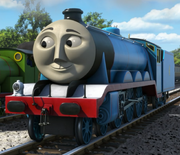

In 2009, the series introduced Computer-Generated Imagery (CGI) as a replacement for the show's long-standing live-action models. Gordon was recreated from scratch in CGI by Nitrogen Studios. His model was "hand-sculpted" in Maya, a 3D animation and modelling software.
Photographs of Gordon's Series 10-12 brass gauge 1 model was used for referencing. According to Greg Tiernan, every detail of the original television series models for each character is carefully reproduced in the CGI model. The models are subjected to many rounds of review before they are submitted to HiT Entertainment for final input and approval. These CGI models have rigs specifically designed for there facial features, wheels, and to power the lights on them. The coal bunkers are made seperate from the model, and are only used for close-up shots, similar to the model series.
In 2016, a new CGI model of Gordon was made by Arc Productions for the special The Great Race. This model depicted him in streamlined casing, with everything bar the face being completely changed. The model was based on a streamlined Pennsylvania Railroad K4 class (a streamlined variant of Hank's class), but modified to fit Gordon's design. The "Shooting Star" model only appeared in The Great Race.
The special also saw the debut of Gordon's brother, Flying Scotsman, who reused a few parts of Gordon's standard CGI model for his own.
In the twenty-third series episode Mines of Mystery, Gordon's cab interior was reused for Lorenzo.
Model Changes
Gordon's CGI model underwent numerous changes throughout the series:
- Hero of the Rails:
- He gained a regulator on either side of his cab, just like the LNER A3 class, a rebuilt and modified class of his basis.
- The wheels on his Bissell truck and tender got larger.
- His tender's height got thinner.
- His tender's length got longer and became the same length as Henry's tender.
- His smokebox and cylinders slightly became longer.
- His eye sockets became smaller.
- His whistle sound became sharper in tone and the harmonic echo effect was made more prominent.
- Series 13:
- The middle sections of his driving wheels are painted black.
- Series 17:
- He gained a permanent head lamp and tail lamp.
- His wheels are fully blue again.
- The Adventure Begins:
- His side rods become silver.
- Series 23:
- He gains another lamp on his left lamp iron, giving him the BR express headcode for the first time since the fifth series episode Haunted Henry.
- He gains handrails around his cab entrance and on his door.
- He gains rivets on his cab, bufferbeams front and sides, the back and sides of his tender, his coupling hook base, around his cab side windows, cylinders, smokebox saddle and around his smokebox.
- He gains red lining on the back of his tender.
Texture Variants
In addition to his standard livery, several other texture variants exist of Gordon's main CGI model. Many only appear once, however a few are reused mutliple times. These texture variants include:
Pantone Colours
The following pantone colours are used on Gordon's CGI model:
- ■ PMS 116 (yellow)
- ■ PMS 299 (blue)
- ■ PMS 428 (white)
- ■ PMS 485 (red)
- ■ PMS 873 C (gold)
- ■ PMS 877 C (silver)
Reference Sheets
Voice Actors
- Neil Crone (Thomas and the Magic Railroad and Thomas & Friends: All Engines Go)
- Keith Wickham (UK; Hero of the Rails - twenty fourth series)
- Stephen Donald (UK; Railway Adventures only)
- Kerry Shale (US; Hero of the Rails - twenty fourth series)
- Rob Rackstraw (Thomas' Magical Birthday Wishes, The Sodor Springtime Parade and Learning with Thomas)
- Salvador Nájar (Latin America; Thomas and the Magic Railroad)
- Jorge Roig (Latin America; Thomas and the Magic Railroad; TV Version)
- Dafnis Fernández (Latin America; Hero of the Rails onwards)
- Harold Salazar (Latin America; Thomas' Magical Birthday Wishes, Learning with Thomas and The Sodor Springtime Parade)
- Salvador Serrano (Spain)
- César Marchetti (Brazil; Hero of the Rails - thirteenth series)
- Sidney Lilla (Brazil; Misty Island Rescue - seventeenth series)
- José Carlos Guerra (Brazil; eighteenth - twenty-second series)
- Mauro Gasperini (Brazil; twenty-third and twenty-fourth series)
- Bernard Demory (France and French speaking Canada; sixth series onwards; excluding the eighth - twelfth series)
- Michel Lasorne (France and French speaking Canada; eighth - twelfth series)
- Leo Richardson (The Netherlands)
- Norbert Gescher (Germany; Thomas and the Magic Railroad)
- Christian Stark (Germany; twelfth series only)
- Tetje Mierendorf (Germany; Hero of the Rails onwards)
- Jürgen Holdorf (Germany; Audio Books only)
- Øyvind Borgemoen Lyse (Norway; Hero of the Rails - Tale of the Brave)
- Ole Møller (Denmark)
- Markus Bäckman (Finland; Hero of the Rails only)
- Pasi Ruohonen (Finland; thirteenth series onwards)
- Adam Fietz (Sweden)
- Karacsonyi Zoltan (Hungary)
- Karacsonyi Zoltan (Hungary)
- Sławomir Pacek (Poland; Hero of the Rails onwards, except Emily Saves the World and Samson at Your Service)
- Miłogost Reczek (Poland; Emily Saves the World and Samson at Your Service only)
- Vladimir Antonik (Russia; thirteenth - sixteenth series)
- Denis Bespaliy (Russia; King of the Railway onwards)
- Danny Segev (Israel; Thomas and the Magic Railroad)
- Nir Ron (Israel)
- Loukas Frangoulis (Greece)
- Kenji Utsumi (Japan; first - eighth series)
- Kenta Miyake (Japan; Calling All Engines! - twenty-fourth series)
- Jeon Tae-yeol (South Korea)
- Shin Yong-u (South Korea; Meet the Steam Team only)

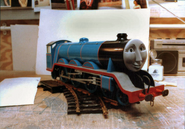
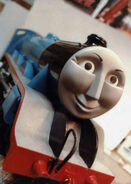
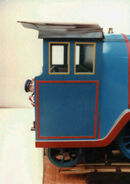





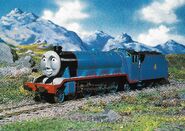

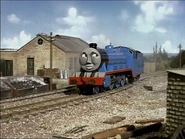


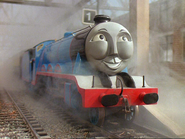
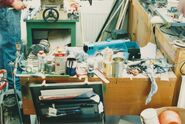
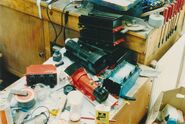

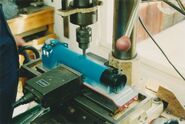
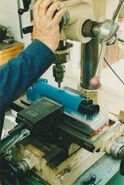


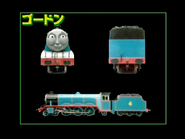




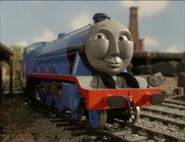
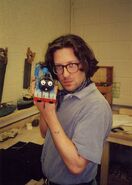
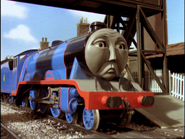
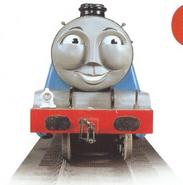
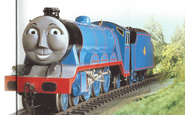

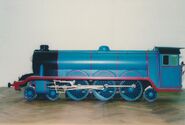


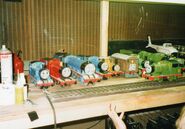
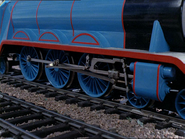
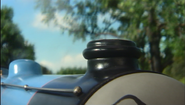
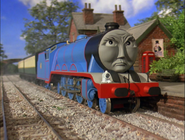

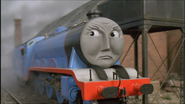
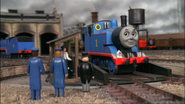




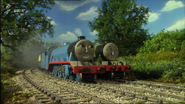
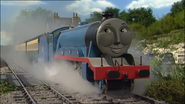
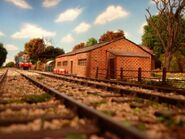












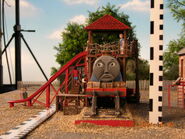




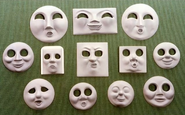
![Series4FaceReference-Gordon.jpg (792 KB) Series 4 - 1994 (Note: His unused first series[3] yawning face between his laughing and neutral faces)](https://static.wikia.nocookie.net/ttte/images/0/06/Series4FaceReference-Gordon.jpg/revision/latest/scale-to-width-down/185?cb=20200325125209)



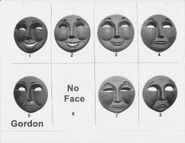
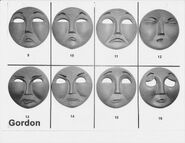
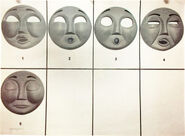
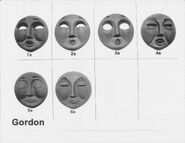


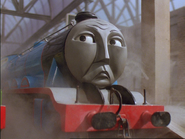
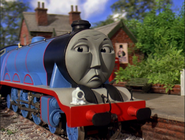



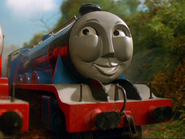
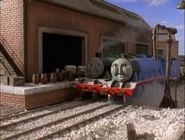

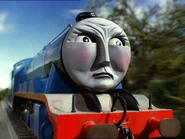
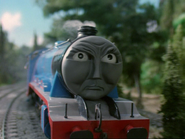

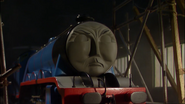

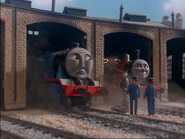



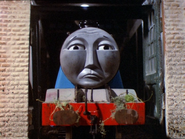

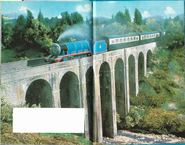
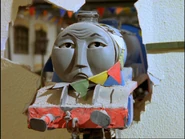



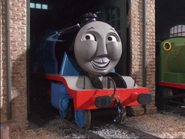

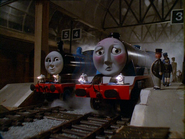



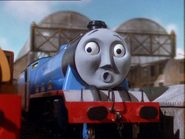
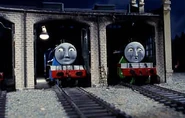

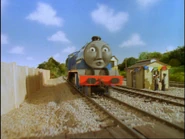

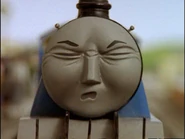
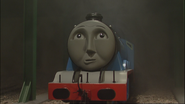
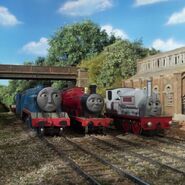

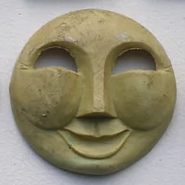
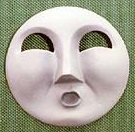
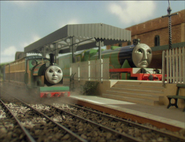


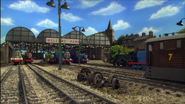




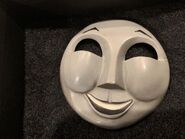




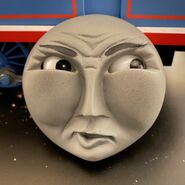



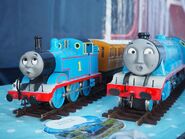









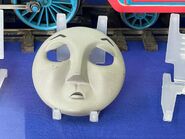

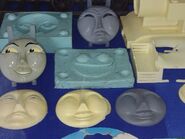




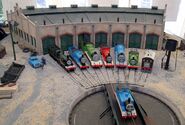
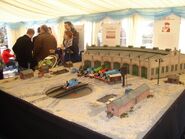
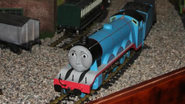

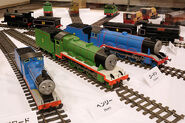
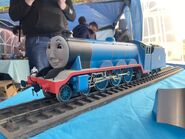
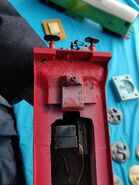

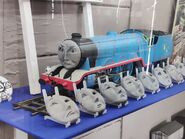

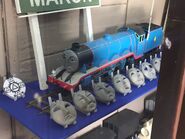
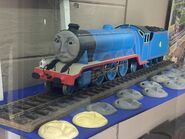




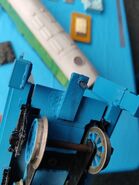
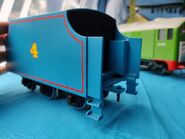
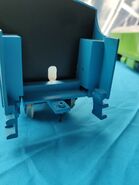







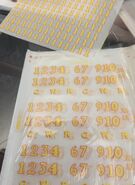
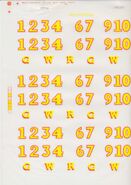
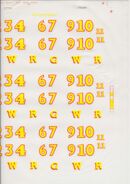








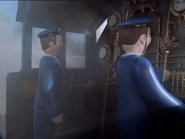












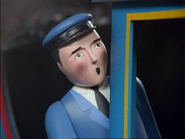
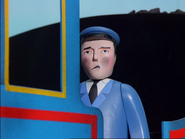
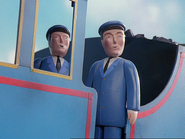

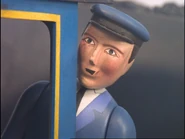
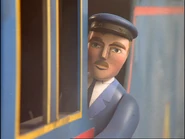
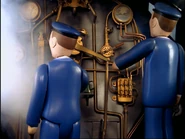
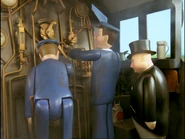
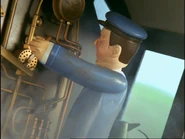
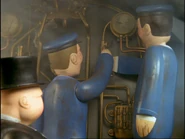
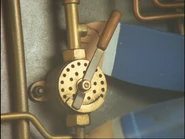
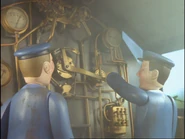
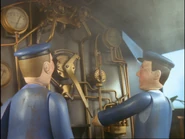
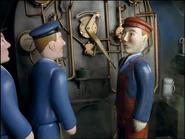
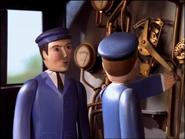
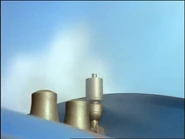


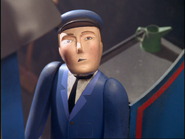
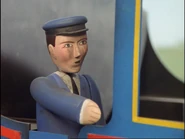







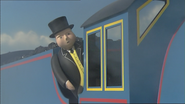


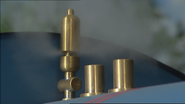

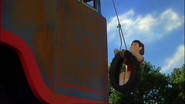
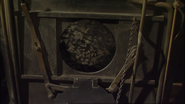
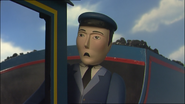


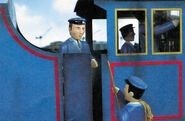
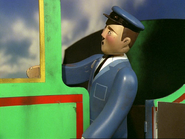


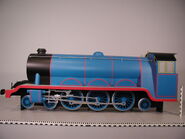



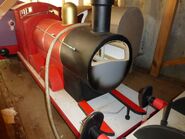
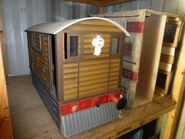

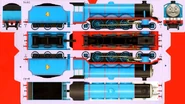




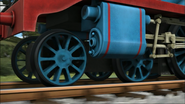
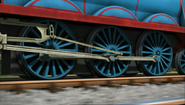
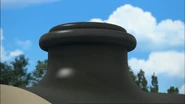
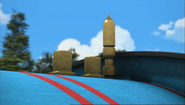



![GordonBack-W-2.791m-L-19.847-H-4.22.png (425 KB) Orthographics for Gordon's Go Go Thomas model [5]](https://static.wikia.nocookie.net/ttte/images/c/c7/GordonBack-W-2.791m-L-19.847-H-4.22.png/revision/latest/scale-to-width-down/123?cb=20231210135706)

